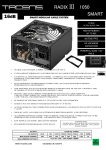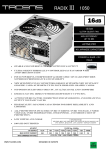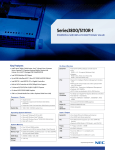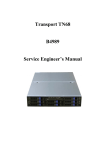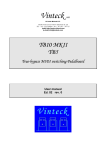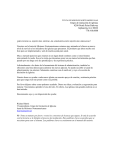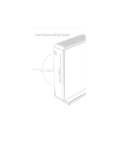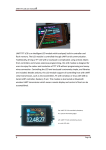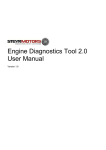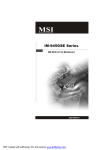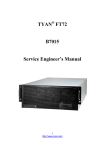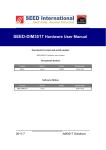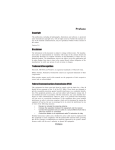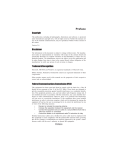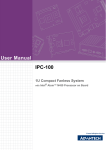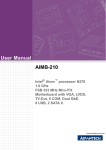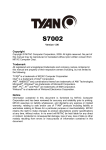Download FWA-3240 Manual
Transcript
FWA-3240 Manual 1U Rackmount Intel Tolapai-based Platform with 4 Front LAN Ports & LCD Display Advantech Internet Security Platform Copyright Notice This document is copyrighted, 2006. All rights are reserved. The original manufacturer reserves the right to make improvements to the products described in this manual at any time without notice. No part of this manual may be reproduced, copied, translated or transmitted in any form or by any means without the prior written permission of the original manufacturer. Information provided in this manual is intended to be accurate and reliable. However, the original manufacturer assumes no responsibility for its use, nor for any infringements upon the rights of third parties which may result from its use. CE Notification The FWA-3240, developed by Advantech Co., Ltd., has passed the CE test for environment specifications when shielded cables are used for external wiring. We recommend the use of shielded cables. 1st Edition Printed in Taiwan March 2006 Product warranty Advantech warrants to you, the original purchaser, that each of its products will be free from defects in materials and workmanship for two year from the date of purchase. This warranty does not apply to any products which have been repaired or altered by persons other than repair personnel authorized by Advantech, or which have been subject to misuse, abuse, accident or improper installation. Advantech assumes no liability under the terms of this warranty as a consequence of such events. Because of Advantech’s high quality-control standards and rigorous testing, most of our customers never need to use our repair service. If an Advantech product is defective, it will be repaired or replaced at no charge during the warranty period. For out-of-warranty repairs, you will be billed according to the cost of replacement materials, service time and freight. Please consult your dealer for more details. If you think you have a defective product, follow these steps: 1. Collect all the information about the problem encountered. For example, CPU speed, Advantech products used, other hardware and software used, etc. Note anything abnormal and list any on-screen messages you get when the problem occurs. 2. Call your dealer and describe the problem. Please have your manual, product, and any helpful information readily available. 3. If your product is diagnosed as defective, obtain an RMA (return merchandise authorization) number from your dealer. This allows us to process your return more quickly. 4. Carefully pack the defective product, a fully-completed Repair and Replacement Order Card and a photocopy proof of purchase date (such as your sales receipt) in a shippable container. A product returned without proof of the purchase date is not eligible for warranty service. 5. Write the RMA number visibly on the outside of the package and ship it prepaid to your dealer. Packing List Before installation, ensure that the following materials have been received: ٛ One FWA-3240 Internet Security Platform ٛ One box of accessories ٛ One warranty certificate ٛ One CD-ROM for user manual (PDF file) If any of these items are missing or damaged, contact your distributor or sales representative immediately. Technical Support and Sales Assistance If you have any technical questions about the FWA-3240 or any other Advantech products, please visit our support website at: ٛ http://www.advantech.com.tw/support ٛ http://www.advantech.com. For more information about Advantech's products and sales information, please visit: ~ Contents ~ 1. General Information .......................................................... 1 1.1 1.2 1.3 1.4 1.5 Introduction ............................................................................ 1 Features ................................................................................. 2 Specifications ...........................................................................2 Dimensions ..............................................................................3 Block Diagram ..........................................................................3 2. System Setup ....................................................................4 2.1 2.2 2.3 2.4 Removing the cover .................................................................. 4 Installing Memory Module .......................................................... 5 Installing Hard Disk Drive .......................................................... 6 Installing Compact Flash ........................................................... 7 3. Hardware Overview ............................................................8 3.1 System Block Diagram .............................................................. 8 3.1.1 3.2 NAMB-3240 Main Board Block Diagram.................................................. 8 Feature Summary..................................................................... 9 3.2.1 NAMB-3240 Main Board hardware function .................................................. 9 4. Hardware Jumper Guide ....................................................10 4.1 PCA Placement .......................................................................10 4.1.1 Main Board Placement .............................................................................10 4.2 Connector ..............................................................................11 4.2.1 Power Supply Connector Pin-out ...............................................................11 4.2.2 Clear CMOS Header ................................................................................11 4.2.3 Fan Header ...........................................................................................12 4.2.4 CF Header ............................................................................................12 4.2.5 PCI Express Golden Finger .......................................................................13 4.2.6 KB/MS Header .......................................................................................13 4.2.7 LPT Header ...........................................................................................14 4.2.8 Console Connector ...................................................................................14 4.2.9 External Serial Port Header ........................................................................15 4.2.10 USB Connector .....................................................................................15 4.2.11 LAN Port ..............................................................................................16 4.2.12 System Reset Header ..............................................................................16 4.2.13 Debug Port Header ................................................................................16 4.2.14 External GPIO Header ............................................................................17 4.2.15 LED Header .........................................................................................17 4.3 General-Purpose IO (GPIO) Assignments and Descriptions .............18 4.3.1 Tolapai GPIO .........................................................................................18 4.3.2 Super I/O GPIO .....................................................................................19 4.3.3 PCA9554 GPIO ......................................................................................19 1 General Information 1.1 Introduction The FWA-3240 incorporates Intel’s Tolapai System-on-Chip which combines Intel's QuickAssist Technology and integrates an Intel Pentium M class core, memory controller and I/O controller. The high-performance CPU core supplies the horse power needed to perform deep packet inspection and other complex operations and is particularly optimized for entry to mid-range network security appliances. Security applications can run existing x86 software applications because of backward code compatible with earlier Intel processors. Most network security platforms already run on Intel x86 processors and can run existing software applications on tolapai because it is backward compatible with earlier Intel processors. Typical appliance workloads which require IP-SEC encryption, acceleration and compression of content can offload processing on to the QuickAssist Integrated Accelerator which increases the effective data throughput and performance and reduces the overall power consumption of a given application. The FWA-3240 features a low-power design, and supports up to 2 GB DDR2 on one single-channel SO-DIMM. It provides a total of four GbE LANs, three of which are from the Tolapai on-chip MACs (Intel 82574-derived) and the fourth from a PCle-based Intel 82574 Ethernet controller. The on-chip MACs are routed to 3 Marvell PHY devices. The system supports one 2.5" SATA HDD and CompactFlash for OS and/or Internet security applications. The front Panel provides a RS-232 serial port with RJ-45 socket, 2 USB ports and a LCD Module for local system management, maintenance and diagnostics. The system is fully FCC, CE and RoHS compliant. 1 1.2 Features 1U Rackmount Network Application Platform Intel EP80579 Integrated Processor (Tolapai) solution One internal proprietary PCle x4 expansion slot Single channel DDR2 SODIMM support up to 2 GB 4 X 10/100/1000 Mbps GbE LAN ports Console port for local setting 1.3 Specifications CPU & Chipset Processor System Intel EP80579 Integrated Processor (Tolapai) supports 600/1066/1200 MHz processor Max. Speed 1.2 GHz Front Side Bus 400/533 MHz BIOS Award™ 4Mbit Flash Technology Single channel DDR2 800/667/533/400 MHz SODIMM Capacity Up to 2 GB with 1 slot Memory Expansion Ethernet Onboard Expansion slots One proprietary internal PCle x4 connector Interface 4 x 10/100/1000 Base-T Controller SATA Storage Peripheral Power Environment Physical Three GbE from Intel EP80579 Integrated Processor + Marvell 88E1111 PHY One GbE from Intel 82574, with bypass function 1 x 2.5" HDD bay Max. data transfer rate at 150 MB/sec Controller JMicron (SATA to IDE bridge) Compact Flash Socket 1 x CF socket on IDE 0 (Primary) USB 2 x USB 2.0 Serial 1 x RS-232 with RJ-45 connector LCD Module 16 Characters. 2 lines. 5buttons Pin headers K/B, Mouse, LPT, COM Watt 180 W Input Temperature 90 ~ 240V AC, auto range Operating Non-Operating 0 ~ 40℃ (32 ~ 104℉) -20 ~ 75℃ (-4 ~ 167℉) Humidity 5 ~ 85% @ 40℃ (104℉) Dimensions (W x H x D) 426 x 44 x 236 mm (16.8" x 1.7" x 9.3") Weight 4.2kg (9.3lb) 2 5 ~ 95% 1.4 Dimensions 1.5 Block Diagram 3 2 System setup Setting up your FW-3240 requires only a screwdriver and a small amount of time. Before you begin, you should also gather together all of the device you plan to install, as well as the CPU, RAM, HDD, and etc. The front panel of FWA-3240 includes a LCD display module, four Ethernet ports, aRS-232 console port, and two LEDs where one is power LED and another is HDD LED. On the rear panel, there is a power switch located on the top right hand corner. 2.1 Removing the cover There are screws which secure the cover to the chassis. They are along the sides, near the top. Remove them, and then slide the cover to the rear of the chassis. Figure 2-1: Remove top cover DDR2 slot Figure 2-2: Inside of FWA-3240 4 2.2 Installing Memory Module 1. Unlock a DIMM socket by. Align the notch of the DIMM memory module to match on the socket and insert the DIMM into the socket until the DIMM is properly seated. 2. Press the DIMM inward to lock the DIMM memory module. Installing memory module is completed. Figure 2-3: Install RAM module 5 2.3 Installing Hard Disk Drive 1. Unscrew each side of the HDD supporting frame on the chassis and pull it out. 2. Put the HDD above the HDD supporting frame and position the screws accordingly. 3. Screw each side of the HDD supporting frame to fix on the chassis. 4. Connect the SATA cable included in the accessory box to the connector on the HDD. Connect power connector to the HDD. Installing Hard Disk Drive is completed. Figure 2-4: Install HDD 6 2.4 Installing Compact Flash 1. Position a CompactFlash disk accordingly in the CompactFlash disk socket and push it inward. Installing CompactFlash disk is completed. Figure 2-5: Install CF card 7 3 Hardware Overview 3.1 System Block Diagram 3.1.1 NAMB-3240 Main Board Block Diagram Figure 3-1: NAMB-3240 Main Board Block Diagram 8 3.2 Feature Summary 3.2.1 NAMB-3240 Main Board hardware function Table 3-1: Overview of the NAMB-3240 major hardware function Integrated chipset z (CPU + NB + SB chipset) Memory Expansion Slots Tolapai 65nm packed in 1088-Ball FCBGA, 3.75cm x 3.75cm Processor with 256K L2 Cache, FSB 400/533 600MHz/1.0 Ghz/2.0 Ghz z One DIMM socket supporting DDR2 SODIMM technology memory. z 200-pin DDR2-533, DDR2-667 and DDR2-800 can be used. z Up to 2GB memory capacity z One full-length/180degree PCI Express x4 slot. z One 3Gbit/s SATA port z One CF Socket z W83793G hardware monitor chip z One 10/100/1000 Intel® 82574L Controller z Three 10/100/1000 RGMII Marvell PHYs z Winbond W83627HG Storage System Management LAN - LPC interface - Support PS2 interface - Support one Paraell port interface Super IO z One DDR2 SODIMM socket z One CF 40-pin connector z One SATA-2 connector z AT-12V Standard on the first 5 pins z 8.4” x 6.5", 6-layer design Internal connector Board Size 9 4 Hardware Jumper Guide 4.1 PCA Placement 4.1.1 Main Board Placement Figure 4-1: NAMB-3240 Placement 10 4.2 Connector 4.2.1 Power Supply Connector Pin-out The motherboard shall accommodate power connectors as described in the AT Specifications. The main connector shall be 7-pin connector as specified in the AT-12V Power Supply Design Guide as referenced above. Figure 4-2: Power Supply Connector 1x7Pin(CN2) 4.2.2 Clear CMOS Header Use a three pin header. for Clear CMOS data Figure 4-3: CMOS Header 3Pin(CN9) Table 4-1: Clear CMOS Jumper Definition Jumper Circuit Comment 1-2 Installed Pull up Pull up to VBAT 3.3V, Normal status (Default) 2-3 Installed Pull down Pull to ground to clear CMOS No install Invalid Invalid 11 4.2.3 Fan Header The number of fans in each platform may be different. Locations of the fan headers shall accommodate circulation of fresh air from the front of the chassis. MOLEX 22-23-2051 with pin out outlined below. Figure 4-4: FAN Header 4Pin(CN1,CN2,CN12) 4.2.4 CF Header 25 X 2 Pin header Figure 4-5: CF Header 50Pin(CN18) 12 The fan header shall be type 4.2.5 PCI Express Golden Finger Figure 4-6: PCI Express Slot 64Pin(GF1 ) 4.2.6 KB/MS Header Figure 4-7: KB/MS Connector 1x8Pin(CN28 ) 13 4.2.7 LPT Header Figure 4-8: LPT Header 2x13Pin(CN27 ) 4.2.8 Console Connector Figure 4-9: RJ45 Connector(CN23 ), the default baud rate is 19200. 14 4.2.9 External Serial Port Header Figure 4-10: External Serial Pin Header(CN20 ) 4.2.10 USB Connector Figure 4-11: USB Connector(CN24 ) 15 4.2.11 LAN Port LED status: GbE Link: Green (Left) FE Link: Amber (Left) Action Link: Green/Blink (Right) Figure 4-12: RJ45 for LAN Connectors (CN25,CN26,CN21 from Tolapai, CN22 from 82574L) Tolapai ‘s LAN LED issues notice: Link LED wasn’t work correctly and plan to fix on next version. 4.2.12 System Reset Header 2 X 1 Pin 2.54mm header Pin Comment 1 Pull up to VCC5 2 Connect to ground Figure 4-13: System Reset Header(CN7) 4.2.13 Debug Port Header Figure 4-14: Debug Port(CN13) 16 4.2.14 External GPIO Header Figure 4-15: External GPIO Header(CN29) 4.2.15 LED Header Figure 4-16: LED Header(CN17) 17 4.3 General-Purpose IO (GPIO) Assignments and Descriptions 4.3.1 Tolapai GPIO Table 4-2: Tolapai GPIO Definition Signals Name I/O Type Tolerance Function Comments GPIO0 I 3.3V GPI NA GPIO1 I 3.3V GPI NA GP2_PIRQE# I 3.3V GPI NA GP3_PIRQF# I 3.3V GPI NA GP4_PIRQG# I 3.3V GPI NA GP5_PIRQH# I 3.3V GPI NA GPIO6 I 3.3V GPI NA GPIO7 I 3.3V GPI NA GPIO8 I 3.3V GPI NA GPIO9 I 3.3V GPI NA GPIO10 I 3.3V GPI NA GP11_SMBALERT# I SMBALERT# NA GPIO12 I 3.3V GPI NA GPIO13 I 3.3V GPI NA GPIO14 I 3.3V GPI NA GPIO15 I 3.3V GPI NA GPIO16 I/O 3.3V GPIO NC GPIO17 I/O 3.3V GPIO Boot options GPIO18 I/O 3.3V GPIO NC GPIO19 I/O 3.3V GPIO NC GPIO20 I/O 3.3V GPIO NA GPIO21 I/O 3.3V GPIO NC GPIO23 I/O 3.3V GPIO NC GPIO24 I/O 3.3V GPIO Connect to PCIE Slot GPIO25 I/O 3.3V GPIO GP26_SATA0GP I GPIO27 I/O GPIO28 SATA0GP 3.3V GPIO Connect to PCIE Slot NA Connect to PCIE Slot I/O 3.3V GPIO GP29_SATA1GP I 3.3V SATA1GP NA GPIO30 I 3.3V GPI NA GPIO31 I 3.3V GPI NA GPIO33 I/O 3.3V GPIO Boot options GPIO34 I/O 3.3V GPIO NA GPIO40 I 3.3V GPI GP41_LDRQ[1]# I 3.3V LDRQ[1]# GPIO48 O 3.3V GPO 18 Connect to PCIE Slot IERR LDRQ[1]# NC 4.3.2 Super I/O GPIO Table 4-3: Super I/O GPIO Definition Signals Name I/O Type Tolerance Function Comments GP10 I/O 5V GPO Port80 LED GP11 I/O 5V GPO Port80 LED GP12 I/O 5V GPO Port80 LED GP13 I/O 5V GPO Port80 LED GP14 I/O 5V GPO Port80 LED GP15 I/O 5V GPO Port80 LED GP16 I/O 5V GPO Port80 LED GP17 I/O 5V GPO Port80 LED GP20 I/O 5V GPI NA GP21/SCL I/O 5V SCL SCL GP22/SDA I/O 5V SDA GP23/PLED I/O 5V SDA NC GP24/WDTO I/O 5V WDTO GP25/IRRX I/O 5V IRRX NC Connect to LAN Bypass GP26/IRTX I/O 5V IRTX NC GP30/SLP_SX# I/O 5V SLP_SX# From Tolapai SLP_S3# GP31/PWRCTL# I/O 5V PWRCTL# NC GP32/PWROK I/O 5V PWROK GP33/RSMRST# I/O 5V RSMRST# GP34/CIRRX I/O 5V GPIO NC GP35/SUSLED I/O 5V GPIO NC 4.3.3 Connect to Tolapai PCA9554 GPIO Table 4-4: PCA9554 Pin Definition Signals Name I/O Type Tolerance Function GPIO0 I/O 5V GPI Connect CN29 Pin3 GPIO1 I/O 5V GPI Connect CN29 Pin4 GPIO2 I/O 5V GPI Connect CN29 Pin5 GPIO3 I/O I 5V GPI Connect CN29 Pin6 GPIO4 I/O I 5V GPI Connect CN29 Pin7 GPIO5 I/O 5V GPI Connect CN29 Pin8 GPIO6 I/O 5V GPI Connect CN29 Pin9 GPIO7 I/O 5V GPI Connect CN29 Pin10 19 Comments Table: Memory compatibility test table Brand PHY num 4 Size Speed 2GB 667 Type ECC REG DDR2 NO NO Vendor PN 78.A2G75.AT5 Memory chip Criteria Measurement Judgment 7XE22 D9HNQ PASS PASS PASS PASS PASS PASS PASS PASS PASS PASS PASS PASS PASS PASS PASS PASS 8AE12 Apacer 4 1GB 667 DDR2 NO NO 78.02G75.AT2 D9HNQ 7XE22 D9HNQ Transcend 4 512MB 533 DDR2 NO NO 76.9325G.B12 0702SP TAIWAN No error 4 2GB 800 DDR2 NO NO 202411-0183 PSC A3R1GE3CFF & PASS 4 2GB 667 DDR2 NO NO 190938-0099 4 1GB 800 DDR2 NO NO 198309-0033 4 512MB 533 DDR2 NO NO 195474-0081 4 1GB 667 DDR2 NO NO 190938-0038 4 1GB 800 DDR2 NO NO AZ28K64B8BJE7S SEC 816 HCE7 K4T1G084QQ PASS PASS 4 2GB 800 DDR2 NO NO AZ56K64E8BJE7S SEC 816 HCE7 K4T1G084QQ PASS PASS 804RAB47 more 7PE11 than 3 D9HNL times in 8AE22 D9HNP SEC 719 ZCE6 K4T51083QC 7PE11 D9HNL test utility. ATP 20

























